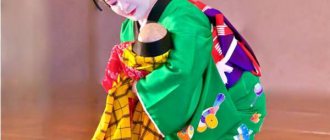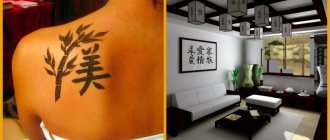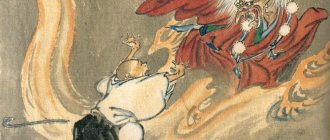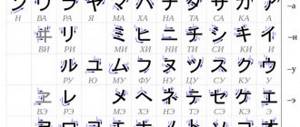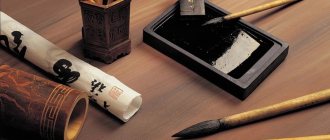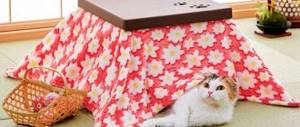History and legends of the origin of the Japanese cat who waves his paw
There are many legends associated with this unusual Japanese amulet. The legends fascinate with their unusualness. Ancient stories are told to tourists who come to the country. This is a kind of national landmark. The following legends are considered the most common options:
- A wealthy Japanese man was driving past a sacred place - the Gotoku-ji Temple. Suddenly a thunderstorm broke out. The traveler took refuge under the crown of a nearby tree. Suddenly he noticed a cat, which seemed to invite him inside the shrine to wait out the bad weather. The wet Japanese man followed into the temple. At this time, lightning struck the tree under which the traveler was hiding. So, a cat saved a man’s life. In her honor, the rich man who escaped ordered a figurine to be made.
- A woman of easy virtue, Usugumo loved cats very much. One day, in the middle of the night, she felt the urge to visit the ladies' room. But her furry pet grabbed onto the kimono and did not let her leave the brothel room. Hearing the noise, the guard came running into the room. He thought the cat had gone mad and cut off its head. The severed part of the body flew almost to the ceiling and grabbed the snake hiding in the corner. Usugumo realized that it was not without reason that her favorite did not let her leave the room. She saved her life. The woman really missed her dead cat. To dispel the sadness of the priestess of love, one of the clients gave her a figurine in the form of a kitten.
- The elderly woman found herself in deep need. There was not enough money even for a piece of flatbread. To improve the situation, the old woman sold her pet cat. But the proceeds soon ran out. The poor thing practically died from hunger. One night she had a dream. The sold cat talked to the owner and convinced her to make figurines similar to him for sale. When she woke up, the woman did just that. People liked the figurines. They sold out instantly. So the cat saved the owner’s life.
You can notice that all the legends are somehow connected with a cat that saved a person’s life. It becomes clear why this animal is so revered in Japan.
History of appearance
There are several versions about the appearance of the Japanese maneki-neko cat.
In ancient times, the abbot of one of the Japanese temples sheltered a cat. The sanctuary itself was in a deplorable state, since no funds were allocated for its repair, which the minister complained about, talking to his cat as if he were an equal. One day a prince drove past the temple. A terrible thunderstorm broke out, and he decided to wait it out near a large tree. As soon as he hid under the crown, he noticed a cat waving
him with his paw.
Surprised, the prince went to the call, and immediately lightning struck the tree, smashing his shelter into splinters. In gratitude
For the rescue, the prince donated a lot of money to restore the monastery. This temple has survived
to this day, and in the first days of spring,
a ceremony
of gratitude is held in it in honor of the Japanese cat Maneki-neko.
According to another version, such a cat saved its owner from a snake at the cost of its own life. Noticing the approach of the creeping reptile, she attacked the girl. A security guard came running in response to the noise and cut off the cat’s head; it flew to the very ceiling, where it bit the snake to death. A cat figurine given by one of her friends was able to console the sad girl.
The third story is about an old woman who, due to poverty, had to drive away her cat. In a dream, an animal came to her and advised her to make a clay figurine and sell it. That's what the woman did. With the money she earned, she supported her assistant and lived in abundance herself.
It is not known for certain which version is the most truthful. But the popularity of the amazing maneki-neko (Japanese beckoning cats) continues unabated to this day.
Appearance and meaning
The main difference between a magic cat and its fellow cats is its red collar. It is connected with the long-standing custom of wearing a red collar with a bell so that pets do not get lost. In those days, cats were elite animals, and rich ladies valued them and were afraid of losing them. The red decoration indicated that the animal was under guardianship and punishment awaited the one who caused harm to it.
According to legend, a Chinese cat with its paw raised invites good luck and happiness to the house where it stands. It is believed that the higher it is raised, the more valuables it can bring.
- the raised right paw invites guests, customers, communicates and is not associated with receiving money;
- the left one invites material values into the house;
- both feet up is a compromise solution for the financial and spiritual components of life.
Figurine color
In earlier times, figurines were not so varied in color. The traditional ones are tricolor, black, red and red. Nowadays, an expanded palette of colors is used to paint figurines, where each color is responsible for one of the areas of life.
- white - chastity and innocence, a symbol of pure thoughts and virtue;
- black - drives away bad people, scares away evil, takes trouble away from home and protects from spirits;
- red - will protect against illness and protect the family hearth;
- pink - will help you find love;
- green - easy comprehension of knowledge, trains memory and develops thinking;
- gold is the color of wealth;
- blue or dark blue is a shade of wisdom and peace of mind.
Objects in paws
Happy cats often hold all sorts of objects in their paws. Depending on them, maneki-neko have different effects.
- golden boar - a coin of one “Re” in those days was the largest denomination, therefore it means untold wealth;
- red carp - wisdom;
- goldfish - money and fulfillment of all desires;
- fan - protection of the house from evil influences;
- fruits - a lot of kids;
- cherry blossom branch - love;
- daruma (tumbler) - wish fulfillment.
The figurines come with open eyes and closed ones; this is also worth paying attention to when choosing a souvenir. Maneko the cat looks into the foreseeable future with an open mind and is aimed at achieving goals in the near future. Closed eyes - responsible for far-reaching plans.
The meaning of the Maneki-neko figurine
There is another version of the origin of the magic symbol. She is quite matter-of-fact.
The cat is the personification of the Japanese courtesan, geisha. And a raised paw is a symbol of inviting a man into the house. One way or another, the figure is associated with fun, luck, and luxury. This meaning has been retained. The talisman is credited with the ability to attract success and prosperity into the life of the owner.
But the exact value also depends:
- from the color of the figurine;
- from the posture of the animal;
- from the object that the cat is holding in his hands.
There are amulets made in the shape of a cat that prolong life and guarantee longevity. Other figures are associated with attracting wealth and financial well-being. The variety of variations makes it possible to choose the symbol that seems most suitable.
Varieties of mascot
In addition to differences in color, the figurine can be made from different materials:
- porcelain - the most popular;
- wood;
- gland.
The maneki-neko talisman is made of porcelain.
There is a particular style in which these figurines are sometimes made. It's called "kawaii". The figurines are decorated with sakura flowers or other cute designs.
Why does the cat have one paw raised?
The question of why the cat is depicted with its paw raised interests many people. Explanations for this fact are found in legends. But there is no clear answer to the question.
Some esotericists associate this with an inviting gesture (legends about a rich man caught in a downpour and a courtesan).
Other experts are inclined to be of the opinion that the figurine is still connected with the ban on visiting brothels. To attract men, courtesans began to use special ceramic figurines - a kitten raising its paw invitingly.
Mosaicism
This kind of thing usually causes psychological problems in people: “Ahhh, what gender am I?!” But cats don’t have any problems. Well, yes, chromosomally hermaphrodite, so what? True, almost all of them are infertile, but somehow the cat has no need to think about it.
But a person with chromosomal mosaicism will usually be very happy when he meets a calico cat: “Hurray, we are of the same blood!” There are quite a few of them - both people and cats... Namely cats, because “Y” is already a definition of the male gender, even though there are more “X’s” than necessary.
Types of symbols and their meanings
Coming to a common opinion on why a cat’s paw is raised is also hindered by the fact that there are figures in different designs. The figurines differ not only in color, but also in pose:
- A cat with its right paw raised is a symbol of good luck and prosperity. Such a talisman is purchased to attract wealth. It is bought by those people who want to improve their financial situation.
- A cat that raises its left paw symbolizes fun and communication. Such a talisman will help you establish contact with people around you.
- A figurine with two outstretched legs represents both communication and financial well-being.
Esotericists claim that the higher the figurine’s paw is raised, the more powerful the energy flow directed towards the owner.
In addition, the meaning of the talisman is also influenced by the color and the object that the cat can hold in its hands.
Japanese Bobtail
This rare breed with a short tail is considered a symbol of happiness in many cultures. Bobtails are intelligent, friendly and playful creatures. They can be extremely cautious with strangers, but they will always find a common language with their family members and will give them their love and care. For the Japanese, the bobtail has always been a symbol of happiness. The Japanese believe in the power of black and red animals. They are the ones who can bring prosperity and success to their owner.
It was previously reported which breeds of cats are considered the most loyal to their owners.
What influences the color of a Maneki-neko figurine?
Japanese Maneki-neko is made in different colors. Depending on the color of the figurine, the meaning of the talisman also changes. Therefore, when purchasing or making it yourself, you need to take into account the desires and needs of the future owner of the amulet.
The classic version of the cat is presented in three tones:
- white;
- red;
- black
This figurine is a symbol of good luck.
Fact! In Rus', from time immemorial, it was considered a good sign to keep a three-haired cat in the house. The Slavs believed that the furry animal would bring good luck to its owners.
- White maneki is suitable for those people who want to develop and learn new things; she is the personification of calm, balance, and knowledge.
- A black cat protects against evil spirits and other evil spirits. The owner is not in danger of damage or the evil eye. With its paw, Maneki-neko calls upon the forces of light to protect its owner. More often the figurine is presented with a coin in his hands and wearing an apron.
- Red Maneki-neko is designed to restore a person’s energy balance. It repels negativity and attracts positive energy to the owner.
- The blue cat helps stabilize the state of mind. This is a suitable talisman for those who lack peace and harmony.
- A pink cat will relieve loneliness. It will make the owner attractive to the opposite sex. It is bought by people who dream of stable family relationships. In addition, this is an ideal talisman for creative people; it relieves melancholy, depression, and mood swings.
In Japan, they believe that a pink kitten with two raised legs will attract the only person with whom the owner will tie his fate.
- Green maneki will strengthen mental abilities, develop memory, and serve students well. This is a favorite mascot of students.
Esotericists recommend choosing a talisman taking into account its color scheme and the object that the figurine is holding in its hands.
Color meaning
Classic – 3-color cat. These are more often found as pets, which is why the figures are usually painted in 3 shades. Canonical is not the only design option for a mascot. Many people like white, black, red, pink specimens. There are options in a heavenly shade and painted to match the color of grass and gold.
The shade is associated with the energy of the talisman. Black ones bring happiness to the owner’s life, protect against troubles, red ones counteract diseases and improve health. Previously, the Japanese believed that red was a cure for measles and smallpox. Such souvenirs are given to the sick or people who are afraid of getting sick.
Pink figurines are associated with good luck in your personal life. They attract tender feelings and promote partner fidelity.
Green souvenirs are considered symbols of security. They are popular with drivers and protect against problems on the road. The same ones help to study, therefore they are used by students and applicants.
The color of Maneki-neko has a special meaning
The following interpretation of colors is known:
- white – happiness, spiritual growth, purity;
- black – protection;
- red – general luck in all areas of life;
- golden - prosperity;
- red – protection from illness, determination, restoration of internal resources;
- pink – romance;
- yellow – happy marriage;
- blue – vitality, favorable relationships;
- green – mastering new things, good memory, creativity.
Correct placement of the figurine in the house
A figurine of Maneki-neko is usually placed in a home. The Japanese say that the amulet must be placed near the entrance to the house. In this case, the figurine symbolizes the hospitality and goodwill of the owners. In addition, it attracts positive energy. This also applies to material well-being.
Sometimes you can see the figurine mounted on a red rug or pad. This is done in order to enhance the magical properties of the talisman.
A small figurine of Maneki-neko can be placed in the workplace, for example, on a desk. Only the kitten’s muzzle must be directed towards the owner. The cat will attract good luck and promote career growth.
Those who want to increase their level of knowledge place a figurine in the north-eastern part of the house. The cat's face should be turned towards the entrance.
In the southeast, the figure is set by owners who dream of forgetting about money problems. Maneki-neko activate the cash flow going to the home of the figurine owner.
The Japanese believe that if you write down your innermost desire on a piece of paper and place it in the foot of a figurine, the dream will certainly come true. That's why in Japanese homes you often find figurines with notes in their paws.
Charms that attract wealth and good luck are used not only in residential buildings. This is a good symbol for organizations. The company will prosper and bring stable income to the owner.
Merchants believe that if the figure is located near the cash register, this will affect profits. Revenue will certainly increase several times.
№1 Siamese cats
Siamese cats
The homeland of the Siamese is Thailand, which was formerly called Siam (hence the name of the breed). Therefore, sometimes representatives of this cat breed are also called Thai.
This is a very ancient breed. Usually it was maintained only by rich and influential people. It was believed that Siamese cats are the guardians of the souls of kings, who retain their strength and grace. Therefore, people believed that Siamese brought success and prosperity.
Popular articles now
Meladze's mistress Erica Herceg in a miniature top showed what attracted him
The star of “The Magnificent Century” Meryem Uzerli took to the red carpet in a dress that went down in history (PHOTO)
The girl has grown up: Masha from “Daddy’s Daughters” boasted a luxurious figure in a transparent blouse
Mesh and two ribbons: Erica Herceg showed a very candid photo in a bodysuit - Meladze does not find a place because of jealousy, and Brezhnev is hysterical (PHOTO)
show more
Is it possible to make a talisman with your own hands?
The classic version of the Maneki-neko talisman is presented in the form of a ceramic figurine. It is quite difficult to create a similar thing at home.
But those who know how to sculpt or felt figurines will be able to make an amulet on their own that will bring wealth and prosperity. In this case, you will need to prepare one of the materials:
- gypsum;
- clay;
- plasticine;
- wool.
The craftsman chooses a color depending on the goals he wants to achieve from the talisman, and sculpts a figure based on the sample.
Some people get creative when making amulets. In this case, they resort to the papier-mâché technique or to cutting out cats from wood, foam plastic, and also create them from paper.
To make such a Japanese cat, you will need:
- Sheet of cardboard.
- Colored paper or markers.
- Glue.
- Scissors.
- Image stencil.
You need to copy the image of Maneki-neko onto cardboard using a stencil. Then paint the kitten in the colors that the future owner of the amulet prefers or cover the cardboard blank with colored paper.
Such a magical souvenir will decorate your desk and be an excellent gift for a close relative.
To enhance the magical properties of the created amulet, it can be supplemented with decorative elements. The Japanese make figurines with various objects in their hands. All gizmos are responsible for one or another area and are designed to help Maneki ensure the well-being of the owner:
- Fan . Eliminates evil spirits, clears the way for the owner.
- Paddle . Guarantees success in any endeavor.
- Fruits . The symbol promotes the conception of a baby.
- Coin or fish. An object in the paws means profit, prosperity.
- Vessel . A kitten with a vessel in its paws is chosen by people who dream of health.
- Plant . A cat with a twig is purchased in order to cope with loneliness.
In addition, Maneki-neko can be decorated with hieroglyphs. Here you need to find out the meaning of the sign.
Japan or China is the birthplace of the figurine?
The money Japanese cat
Maneki-neko or Alluring Cat comes from Japan. Since the figurine was brought to China, it immediately fell into the category of talismans most revered by the Chinese. In this country, its name sounds like “Lucky Cat”, and the legend of its origin has several versions. The cat is a symbol with ancient history, which is bought to attract money or good luck, and is also given to relatives and friends with the best wishes.
People often endow a talisman with miraculous powers, and a Japanese cat, waving its paw welcomingly, can be seen not only in homes, but also in shops, cafes or offices for success in business and prosperity in all endeavors.
Don't miss an interesting article on Talisman about the money toad - a powerful talisman for attracting wealth.
